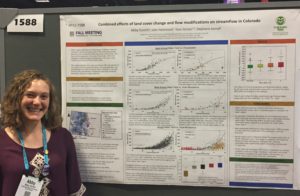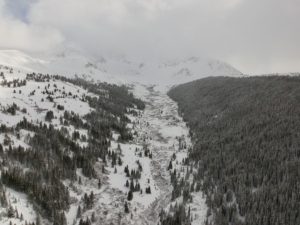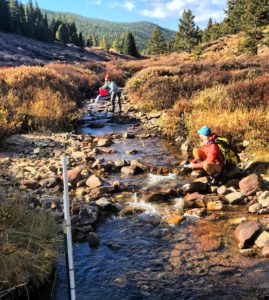
Graduate Student Spotlight – Abby Eurich won Outstanding Student Presentation at AGU
Abby Eurich, a master’s student in the Watershed Sciences program received the “Outstanding Student Presentation Award” at the meeting of the American Geophysical Union (AGU) in December 2018. Congratulations, Abby! This presentation highlighted a portion of the work she has been doing over the past two years in collaboration with her advisor Dr. Stephanie Kampf, Dr. John Hammond (NREL alumni), and Tony Vorster (current NREL PhD candidate).

Abby is one of the few graduate students at Colorado State that is a native Coloradoan. Growing up in Denver, Abby has borne witness to significant landscape-scale changes in Colorado, from extensive forest mortality due to the mountain pine beetle outbreak to the development of her quiet Denver neighborhood into the bustling metropolis it is today. While observing these modifications to the landscape, Abby became curious as to what the resulting hydrological impacts would be. As an avid skier, Abby also wondered what impact ski resorts have on the hydrologic cycle at high elevations.
Abby now studies the relationship between snow persistence, the percent of time snow is on the ground from Jan. 1 to July 3, and water yield, the volume of water measured as in-stream flow. Her research focuses on investigating the effects of land use change and forest disturbance events on the relationship between snow persistence and water yield. To do this Abby collects stream gage data from across the state. Looking at the data she was quickly surprised by the results, because the data were quite different from what she was expecting.

Abby and her team of researchers found that transbasin diversions and flow modifications, now quite prevalent across Colorado, have a large impact on water yield. The first transbasin water diversions were built in the 1800’s to carry water from the West slope under the Continental Divide and into East slope river basins, mostly to support agriculture and mining practices. Now Colorado, like most of the west, faces a grand challenge of providing reliable water to the bulk of the population, which invariably resides where the water is not. The Continental Divide passes straight through Colorado, separating our watersheds. Most of the snow falls west of the Continental Divide, while the population primarily lives east of the divide.
Currently, transbasin diversions provide over one million acre-ft of water annually to the East side of the divide, used now for both agriculture and municipalities. For example, the reservoir here in Fort Collins, Horsetooth Reservoir, is fed almost entirely by water from the Colorado River via the Colorado-Big Thompson Project, which started in 1938. These transbasin diversions alter streamflow from what would be expected under natural conditions in both the basin in which the water originates and the receiving basin. Diversions out of a watershed reduce streamflow and diversions into a watershed increase streamflow in comparison to natural flow conditions. Abby and her colleagues realized that in order to answer the original questions related to forest disturbances, they first needed to identify which study watersheds had diversions to distinguish between natural flow conditions and modified flow.

Through this work, Abby has found that using the relationship between snow persistence and streamflow, she can very clearly separate the watersheds with transbasin diversions (either in or out). The watersheds called “within basin modification” for this study may have small diversions but the diverted water remains within the same watershed resulting in no changes in flow at the stream gage.
Now that Abby and the team can separate watersheds with a natural (or expected) flow regime, they are returning to the original question, are there significant effects of disturbance and land use change on water yield across the state? To answer this question comprehensively, they are also developing a new model to predict streamflow in un-gaged basins, using snow persistence as a primary predictor variable, and also incorporating other predictors such as elevation, aspect, and hydrologic regime. Through this work the team will investigate the relative importance of climate variability, land use change, transbasin diversions, and forest disturbance (including fire, bark beetle, and harvest) on annual water yield in these Colorado watersheds. These analyses will be instrumental for water planning in the state of Colorado as we move into a very uncertain future.